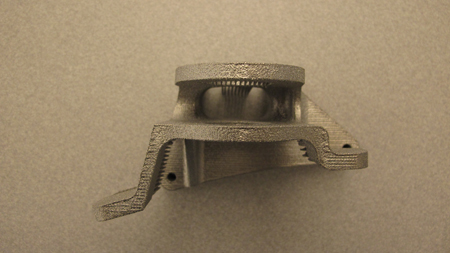 Hartford, Conn. Additive, or “3-D” printing is rapidly becoming the rage in the aerospace industry, and its proponents are suggesting that someday—possibly soon—whole complex mechanical systems will be made using the technique. However, “I think there will always be a place for castings and forgings,” said Lynn Gambill, Pratt & Whitney’s chief engineer for manufacturing engineering. During a media tour of Pratt’s additive manufacturing facilities, Gambill told Air Force Magazine that while 3-D printing is beyond its infancy stage, it still has a number of drawbacks. It can take as much as 20 hours to “print” a five-inch tall part, and even after it’s done, it will still need work to remove spacers and polish the surfaces, which emerge from the metal powder process with a matt finish, not yet ready for many aerospace applications. The time element can be reduced somewhat by making multiple parts at a time, but the decision to produce with additive rather than a casting or forging “depends on the part,” and how complex it must be. Some shapes “can’t be created with any other process,” she said. Pratt displayed parts used in engines whose weight was reduced 80 percent from their original versions, thanks to 3-D printing.
Hartford, Conn. Additive, or “3-D” printing is rapidly becoming the rage in the aerospace industry, and its proponents are suggesting that someday—possibly soon—whole complex mechanical systems will be made using the technique. However, “I think there will always be a place for castings and forgings,” said Lynn Gambill, Pratt & Whitney’s chief engineer for manufacturing engineering. During a media tour of Pratt’s additive manufacturing facilities, Gambill told Air Force Magazine that while 3-D printing is beyond its infancy stage, it still has a number of drawbacks. It can take as much as 20 hours to “print” a five-inch tall part, and even after it’s done, it will still need work to remove spacers and polish the surfaces, which emerge from the metal powder process with a matt finish, not yet ready for many aerospace applications. The time element can be reduced somewhat by making multiple parts at a time, but the decision to produce with additive rather than a casting or forging “depends on the part,” and how complex it must be. Some shapes “can’t be created with any other process,” she said. Pratt displayed parts used in engines whose weight was reduced 80 percent from their original versions, thanks to 3-D printing.
KC-46’s Refueling Boom Damaged While Refueling F-22s
July 8, 2025
A U.S. Air Force KC-46 tanker suffered damage to its boom while refueling F-22 Raptors off the coast of Virginia on July 8, Air & Space Forces Magazine has confirmed, with reported radio communication from the crew indicating the boom “detached.”